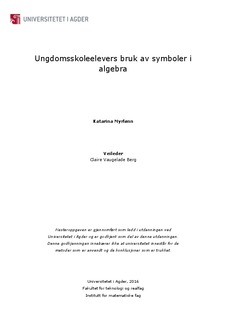| dc.contributor.author | Myrlønn, Katarina | |
| dc.date.accessioned | 2016-09-30T13:06:07Z | |
| dc.date.available | 2016-09-30T13:06:07Z | |
| dc.date.issued | 2016 | |
| dc.identifier.uri | http://hdl.handle.net/11250/2412292 | |
| dc.description | Masteroppgave matematikkdidaktikk – Universitetet i Agder 2016 | nb_NO |
| dc.description.abstract | The thesis investigates the challenges students in 10th grade face while learning algebra, algebraic symbols and how they assess the subject. With the use of a theoretical test and semistructured interviews, the thesis aims to answer the following research questions: 1. What challenges do students from lower secondary education encounter while learning algebra? 2. How do these students engage with algebra and what are their views and aspects towards the subject? The thesis serves primarily as a qualitative case study, of three students from lower secondary school. In addition, quantitative research methods have been undertaken by collecting the results from the entire class. By keeping the interviews semi-structured, the researcher had the opportunity to ask spontaneous questions relative to the student’s response. In addition, an interview guide has been used to build a general format for the interviews. The theoretical framework of this study is based on some of the basic ideas in the sociocultural learning theory; semiotics, Steinbring’s epistemological triangle; Sutherlands learning path; looking through vs. looking at; Küchemann’s categories and levels describing students’ interpretation of symbols. The framework is also based on literature, which review mediation and semiotic representations, as well as instrumental and relational understanding. The study displays that the students face diverse challenges, which vary between tasks. The students varying approach to algebra may be one of many reasons for this difference. One of the resurfacing challenges predominantly encompasses how the students will interpret a task while keeping the algebraic expression parallel to the context. Another challenge that arises repeatedly is the students’ ability to interpret how the context is presented through the use of algebraic symbols. Even though the quantitative sample in this study was limited to 20 students, it is reasonable to assume that my findings will also apply for similar demographics. | nb_NO |
| dc.language.iso | nob | nb_NO |
| dc.publisher | Universitetet i Agder ; University of Agder | nb_NO |
| dc.subject | algebra | nb_NO |
| dc.subject | matematikkundervisning | nb_NO |
| dc.subject | ungdomstrinnet | nb_NO |
| dc.subject.classification | MA502 | |
| dc.title | Ungdomsskoleelevers bruk av symboler i algebra | nb_NO |
| dc.type | Master thesis | nb_NO |
| dc.subject.nsi | VDP::Mathematics and natural science: 400::Mathematics: 410 | nb_NO |
| dc.subject.nsi | VDP::Social science: 200::Education: 280::Subject didactics: 283 | nb_NO |
| dc.source.pagenumber | VIII, 82 s. | nb_NO |
